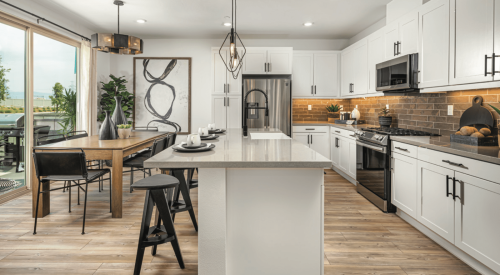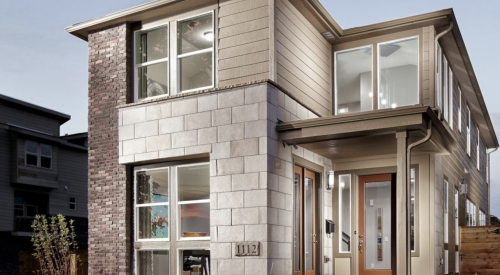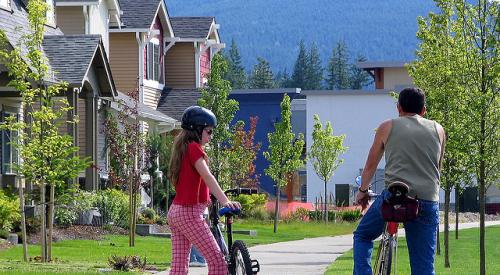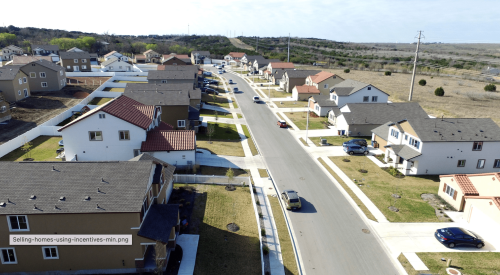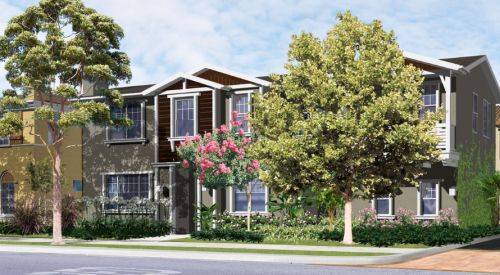
Investment management firm 13th Floor Investments targets for- purchase underperforming properties that could generate cash flow if redeveloped and combined with a well-executed operating strategy. The firm’s building division, 13th Floor Homes, has created a growing niche business by transforming golf courses into residential communities.
The company’s success isn’t so much a result of golf’s waning popularity as it is of South Florida’s glut of 18-hole courses. Decades ago, developers established golf communities not because those facilities were justified by an economic model but because golf helped houses sell. Today Florida has the most courses in the country, with 1,146; 177 of which are in Broward, Dade, Miami, and Palm Beach counties, according to the National Golf Foundation. The number of courses nationally has contracted by 7 percent since 2006, and the reduction has been most acute among value-priced facilities that charge less than $40 green fees.
Those unprofitable operations, public and private, are the land targets that 13th Floor Homes seeks to redevelop into communities such as Avalon Trails, a 55-plus community of 521 homes to be built on 107 acres in West Delray Beach.
Q: When you redevelop a golf course, are you keeping that activity somehow or are you replacing golf with other activities?
A: In almost all cases, we’re working on repositioning former golf courses. We’re removing golf in its entirety, and we are doing so for a couple of reasons. First off, we are positioning our program moving forward and are trying to meet the demands of today’s buyers, most of whom are looking for different amenities, as opposed to golf.
Secondly, the game of golf certainly isn’t going away, but it is going through something of a reset. Most of the golf courses we’ve been involved with fall in what I call the value spectrum, and those value-spectrum golf courses are the ones that are really hurting and need a subsidy to keep going. So as not to saddle our potential buyers or neighboring communities with that subsidy, we just remove golf entirely.
We’re usually buying into existing communities that surround these golf courses, and what we find when we survey residents, or even when we talk to the golf course owners, is that typically less than 10 percent of community residents are actually using the golf course for golf. Most are there for the view, or they like that they’ve got a nice, open space to walk around during the evenings. That’s their use of the golf course. If we can at least address the second component of that, we find we usually can get people onboard.
Q: What are the typical NIMBY objections, if any?
A: Of course, we get people who don’t want to lose the golf course. This typically is the first objection. The others are the typical NIMBY complaints regarding construction noise and debris. Maybe unique to golf courses are the environmental concerns. I think enough golf courses have been redeveloped that people understand that they’re not the most environmentally friendly things—with all the pesticides, chemicals, and fertilizers used in their operation. Some people have concerns about where all that is going to go.
We certainly get complaints about housing values, different neighbors moving in, and the views being affected. A lot of those are commonplace objections on top of those that are specific to golf courses, so it makes our lives a little more challenging in that respect.
Q: How do you address those objections, particularly declining property value fears?
A:The way we go about it, which is somewhat unique in our market, is we address these objections head-on. It’s a lot of work and is a pretty heavy lift, but we go through the effort of meeting with these communities and making the community part of the solution. It’s only by way of that approach that we’ve seen success in golf course redevelopment. We try to make them part of the process. Maybe it sounds arrogant ... but we try to educate them about what is happening with the game of golf. Why are these courses closing; what that other approach (the playbook) is, and why that is a worst-case outcome for them as much as they may hate us on the front end. Hopefully if nothing else, they will listen and work with us as we try to come up with something that results in a beneficial outcome for all the stakeholders.
We know we are not going to get everybody on our side. There are still people to this day that don't like us because we took away their golf course. But redevelopment for most of these courses golf course redevelopment for most of these courses is inevitable. You take a market like Broward County; it is effectively built out. The largest green swaths of land when you look at an aerial photograph are golf courses, and many of them are losing millions of dollars each year. With that dynamic in play, something is going to happen in time. So our approach is trying to get the community to at least recognize that that is the case and to try to be part of the solution.
The biggest fear in these communities is we are going to come in and build affordable housing that also is going to take down the value of their homes. Or more specifically for those people who are on the golf course, when we take away those views they will lose their quote unquote golf course premium. I put that in quotes because what we have seen firsthand in a number of these communities is that premium that once existed for that golf front view maybe was there to some extent but it's not nearly what people perceive it to be. A lot of that decline in the golf view premium is a function of the fact that if you are living on one of these value golf courses in South Florida right now, there is a high value of uncertainty about what is going to be in your backyard later. With that high level of uncertainty it has a sort of paralyzing effect on these communities and on these sort of premiums and values that they can get. Lifting that uncertainty is important then working with them in some sort of plan that ultimately will increase their property values.
In all the cases where we have redeveloped, we have actually seen that occur. We've done our own studies on property values internally and hired John Burns (Real Estate Consulting) at one point in time to do a study for us to show the effect on values in neighboring communities. (Redevelopment) actually had a very beneficial effect on those communities, and some of them improved even more than what our normal market recovery was experiencing, implying somewhat that our community lifted that market more than just the general improvement we were seeing.
Q: When the neighbors see those numbers does the opposition melt away? Do you at least get a foothold?
A: We do. It takes time. The way we always rationalize that is you're kind of hitting in two places. You're hitting them in the brain and logic and you're also getting them in the heart. A lot of these people have lived on the golf course and have known it for the better part of their lives in some cases. We understand that because we are the developer, unfortunately when we walk into the room, we often have the same perception that an attorney or a politician would have. There is a high level of distrust. So it helps, and you certainly turn some people in your initial meeting but to really turn the tide requires a good bit of time in a community and a good bit of one-on-one reaching out with people, so they can understand who we are. We can give them data support for what we are saying so they can look at it and you can make your own decision.
Q: How much time do you plan for that outreach approach?
A: We always assume a baseline of six months. It varies depending on support for the deal we are looking at, how big the neighboring communities are but in order to run our approach in genuine fashion the way we want to run it you have to give yourself time because we want to meet with (residents) to introduce the concept. Then we have to get their feedback and revise our plan based on their feedback, which takes time. We also have to work with all our third parties--our architects, our engineers--and everybody else to try to factor in as much of their feedback as possible and then come back to the community ultimately. We could try to cram that all in to three months, but we always assume it will take longer. We just closed on a golf course in Palm Beach County that was age restricted. The community and residents weren't there when we wanted to work on the program so we had to wait around until they came back into town in November and pick up in December. So you always find that there are elements that are thrown into the mix that make things take a little bit longer.
Q: Do you build multifamily and different single-family products so all your eggs are not in one basket?
A: We are a small enough builder, so we can take the approach in our communities were we try to match, if nothing else, the architectural context of the existing community. We think that is working because having a stark contrast with what your neighbor has doesn't go over very well, We are working on one right now where existing community has a sort of Mid Century Modern aesthetic and that was very important to the residents. So our homes are going to be different. They might be smaller lots than what existed in this community, but they are still holding true to the architectural style. We think that is important. While our floor plans might be similar across communities, the elevations are changing from community to community to match the fabric of the existing community.
As far as rentals go, we have done that on one of our projects. It is actually the age-restricted community with 521 residential homes, 200 of those being multi family, age restricted rental. I would tell you that as you try to put rentals in an established single-family, fee simple for sale community, you usually get a good bit of resistance, particularly from the demographic that perceives renters to be different in their lifestyle than what an owner might be. In most of these cases we are doing rental housing that on a monthly basis are pretty similar to owning so you are getting renter by preference as opposed to renter by necessity. As such I think you hold up the quality, which as you can imagine is very important to these existing establishments.
Q: I imagine an example of a preferred renter is someone who is an owner who wants to downsize and stay in the community. Is that a situation that you come across?
A: That is exactly right. We got a lot of interest in that. The one community in Dell Ray, the Palm Beach County one, there is an established community of 3,742. I will never forget that number because we had to get consent from over two thirds of that community for rentals. When I first heard that number, I said it's never going to happen but ultimately we were successful. We were shocked with the amount of support and interest that we received from the community for the rental housing. Many were condominium owners who would have liked to sell their place and were looking to go into rental housing but that option wasn’t open to them. The other renter by preference is a try-before-you-buy renter who wants to try out the community. People are willing to rent for a couple of years before they plunk down $400,000 to $500,000 on the townhome or a single-family home, They just want to make sure that they like the life style. In an age restricted setting, the utmost importance to these people is it's not as much about the home as it is the lifestyle and the community that they are a part of.
Q: Is there much of a distinction between buyers that are interested a 13th Home community compared with buyers whom bought into a golf community?
A: I don't know if there is that much of a departure from who would have ordinarily bought in that community today because a lot of people are not buying for golf. They are buying more for location, lifestyle, community and when I say community I mean the people who are around them, or family. So we are selling in the same way as the existing communities that surround us. The difference is as opposed to us building in true suburbia or true exburbs that are just way out there on virgin land that the buyer who is willing to drive 40 or 45 min. to work every day. We have a little bit different of a buyer who is truly looking for a new suburban experience. Because we are in an established community typically we’re getting a buyer who wants to be more proximate to their point of center or to their family and are willing to trade off a little bit of the typical suburban community for something that is little different, more creative, and part of an established community and has a lot of things that are ready in that area.
Q: What are some of the challenges with golf course the development besides people?
A: There are no shortages of those either. There is the ordinary due diligence that you do when you're buying any other piece of land but when you get to golf courses everything gets a little more heightened especially in established communities. The biggie that we face is number one, environmental. That is huge. Golf courses are not green environmentally friendly uses. There is usually a lot of upfront due diligence we need to do as it relates to what sort of chemicals, pesticides, fertilizers were involved in the operation of the golf course and what do we need to do according to the state or county, whoever the governing authority is, to mitigate that so it is appropriate for residential uses. You can usually determine that in a relatively short time frame and have your conversations with the state. Fortunately in Florida we have pretty clear guidelines about what needs to be done to a site so we can look at what we found, what we need to do, and figure out what the cost is going to be.
Another thing that becomes extraordinarily important with golf courses for our geotechnical studies, basically looking at the subsurface condition and the soil. What we find is some of these older communities as they were developed probably with pretty lax regulation and inspection is a bunch of the crude. A bunch of the garbage finds its way to a golf course as they were developing around it and some developers used the golf course as a place to put all the bad materials, so we always have to look at that very closely as we are going in.
The last one would be drainage and just overall engineering. It always ends up being a bit more complicated, and that's just because you are in an established community that already has roads and drainage designed for that existing community. So when you come in and start modifying things it becomes particularly challenging. Golf courses in a lot of ways do actually act as the drainage for neighboring communities so we always have to look at ways where we can accommodate drainage for the new project and eventually for the neighboring communities. In many cases we even have to improve the drainage for neighboring communities as many of them were designed many years ago and as a result are not really designed to today’s standards or to withstand the rain and flooding events that we get now.
Q: What are the amenities that are replacing golf?
A: The same type of amenities that are popular in a true suburban type of community setting is what we find is really popular in these communities. Fitness is a huge thing right now and anything that we can do with a fitness or with a wellness slant to it typically does really well both with our existing communities and our new residence. They also are looking for walking trails, park courses with little fitness stations along the trail. Pools are still the center of activity, so having resort style pools is pretty important. Gathering space especially in golf course communities ends up being popular as well. Many of those communities have a clubhouse that acted as the gathering place for the community. To the extent that we can preserve the existing clubhouse and the gathering spaces as a part of it or if we have to build a new one--we’re typically doing bigger clubhouses with larger gathering rooms than we ordinarily would with a site on virgin land. Those are the biggies. There are always little things that seem to be coming in and out of favor, right now like having co-working space as part of these clubhouses, or a cafe, Wi-Fi like setting also are very important.
Q: Anything else about how you address fears about declining property values?
A: I think the real way to address the property value arguments is show people what you are going to build, show people what you are going to sell those homes for and then ultimately how, even if it's not next door, show how that has played out of those communities. That is what we always try to do, and that is where we feel confident because we have done it before, and we’ve seen firsthand that it will have the same effect on the new communities we are part of.
Q: What can you tell us about how golf course closures are helping to sustain the sport?
A: In the last decade here in South Florida, I think there have been over 40 golf course closures. Some of those went through that playbook scenario that I mentioned earlier, and some being redeveloped in the way that we talked about or in another fashion.
As far as the impact that the closures have had on golf as a whole, what is interesting at least in our market is it hasn’t proven out to be the efficient economic model. As you decrease supply, you should start to see those other courses benefit from that. In fact we see a continued decline in golf despite the number of closures in our market. We attribute that to two things: number one, South Florida, as many people recognize is wildly over golfed. I think there are more golf courses in Florida than in any other state in the country, most of which were not built as being economically viable, but were just built to sell homes or just because land was available. There really wasn’t a good economic reason to build them. Separately (reason two) we’ve got a changing demographic in South Florida that doesn’t have the same preferences or lifestyle that the demographic 10, 15, 20 years ago had where they were supporting golf courses.
Those two factors are enough in our mind to basically come to the conclusion that a lot more golf courses need to close before we get back to that point of equilibrium where there are courses, even those in the value spectrum that can make money.

